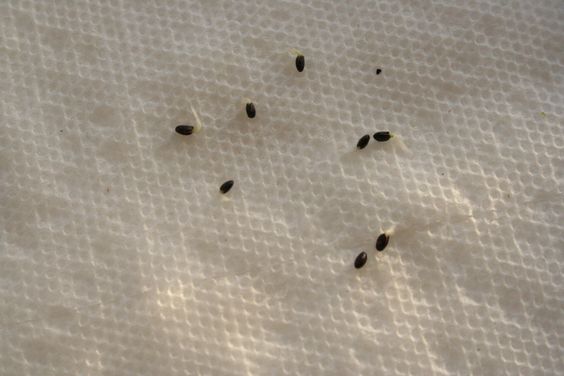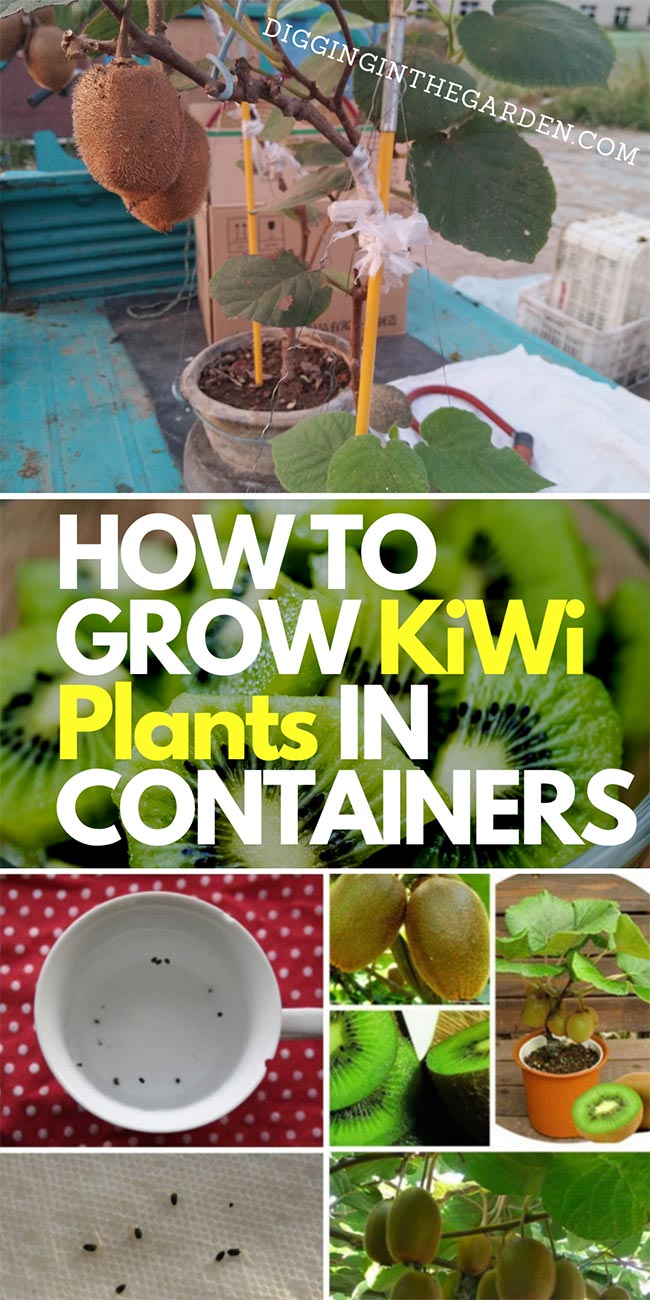How To Grow Kiwi Plants In Containers
Kiwis are a warm-weather fruit that most people would never dream of trying to grow themselves, which is unfortunate because they are actually pretty easy to cultivate at home. Smaller, smooth-skinned varieties such as Annas or Issai grow well in pots and produce fruit that is sweeter than the fuzzy ones you get at the supermarket. Once you get your kiwi plants established they will take a couple of years to start producing fruit, but a mature plant can produce 50 lbs of fruit per season and will continue to grow and produce fruit for 40 years. There is no better time to get started, so let’s learn how to grow kiwi plants in a pot.

#1 Planting Zones
Kiwi plants have a broad range of suitable zones, making them a great addition to many gardens. Generally, kiwis grow well in zones 5 to 9, but there are some varieties that can tolerate the cooler temperatures of zone 3. To determine which kiwi variety is best suited for your climate, it’s best to consult with a local garden center.
#2 When to Plant Kiwi
When planting kiwi, timing is key to ensure the plants get off to a strong start. Ideally, kiwi plants should be planted in the spring, after the last frost has passed. Although there are some kiwi varieties that can withstand colder temperatures, young plants are not as cold-tolerant.
#3 Growing from Seed
1. Growing kiwi from seed can be a fun and rewarding experience, particularly for children. While it may be time-consuming, it’s worth the effort to see the tiny seeds sprout and grow into healthy plants. For the best results, it’s recommended to use an organic kiwi to obtain seeds that are more likely to produce fruiting plants.

2. To begin the process, remove the seeds from the fruit and wash them in water to remove any pulp. Then, place the seeds in a coffee cup filled with tepid warm water, changing the water daily for about a week. After a few days, the seeds will begin to open, so it’s helpful to use a magnifying glass to monitor the progress.
3. Once the seeds have opened, place them on a damp paper towel and cover them with a plastic container or wrap that has air holes. Store the container in a warm place and check on the seeds regularly. If germination is successful, you’ll see the seeds sprout in just a few days. Gently plant the seedlings in small pots with high-quality seed mix, being careful not to damage the delicate roots.
4. To plant the seedlings outside, wait until the spring temperatures are warm and frost is no longer a concern. If there is still a risk of frost, consider using a cloche to protect the young plants. With proper care, kiwi plants grown from seed can thrive and produce fruit in the right conditions.
#4 Getting Started
To make sure your kiwi growing is successful, you will want to make sure you have the right items on hand.
- A kiwi nursery container. (You can grow kiwis from seeds, but you need a male and female plant to produce fruit and it is easier to guarantee this if you get your starts from a nursery)
- Pots
- Soilless potting mix with at least 1/3 organic material (kiwis like good drainage and do not like standing water)
- Bone meal or well-composted manure to mix into your soil as fertilizer
- A trellis for each plant
#5 Planting
Once you have gathered all the necessary items, it is time to get planting.
- Fill your potting containers approximately 2/3 full with your potting mix and fertilizer.
- Remove your kiwi plant from the nursery container.
- Place a male and a female plant on either side of your centered kiwi. You need both for successful pollination and fruit growth.
- Fill the pot the rest of the way up with soil. Make sure to leave a couple of inches between the top of your soil and the top of the pot for watering.
- Set pots near a trellis. You may need to use a stake to encourage growth towards the trellis as you would with a tomato plant.
Below is a video tutorial for How To Grow A Kiwi Plant From Seed:
#6 Care
- Kiwis love sun and warmth and do best in full sun. If you are in a cooler climate try setting them next to a south or west-facing wall to optimize warmth. You can also keep them indoors near a south-facing window.
- Give your plant a couple of inches of water 3-4 times a week. This is where it is crucial that your soil drains properly or your kiwis will develop root rot.
- Every few weeks you will want to cut about half of the new growth from each branch. This encourages your plants to grow more bush-like and encourages flower growth which is vital for pollination.
- Fertilize your kiwi plants once a month during the summer growing season.
- Be sure to train your kiwis to use the trellis you have provided to avoid breakage.
#7 Some additional tips and information on growing kiwi plants in containers:
Choosing the Right Varieties: As mentioned earlier, smaller, smooth-skinned varieties like Annas and Issais are great for container growing. But there are also other varieties to consider such as the hardy kiwi (Actinidia arguta) and the cocktail kiwi (Actinidia arguta ‘Issai’).
Proper Drainage: Kiwis need well-draining soil, so make sure to add some perlite or vermiculite to your potting mix to improve drainage. You can also consider adding a layer of gravel at the bottom of your pot to help with drainage.

Pollination: As kiwis require both male and female plants to produce fruit, it is important to ensure that you have at least one of each. You can identify male plants by their flowers, which are smaller and less showy than the female flowers. If you are unsure which plants are male or female, ask your nursery or check the plant tags.
Trellising: Kiwis are vigorous climbers, so providing a sturdy trellis is crucial to support their growth. You can use a variety of trellising methods such as a bamboo teepee, a wire fence, or a wooden frame. Make sure to secure the trellis well and train the vines to grow along it.
Pruning: Regular pruning is important to maintain the shape and size of your kiwi plant and encourage fruit production. Prune in late winter or early spring before new growth begins, and remove any dead, diseased, or crossing branches. You can also prune back the new growth in summer to encourage bushiness.
Pests and Diseases: Kiwis are susceptible to a number of pests and diseases, including spider mites, aphids, powdery mildew, and bacterial canker. Make sure to inspect your plants regularly for signs of damage or disease and treat them promptly.
#8 Preventing and Treating Common Kiwi Plant Diseases
Leaf Rollers: Managing Infestations
Leaf rollers are small caterpillars that can infest your kiwi plants, creating a silk home on the back of leaves and rolling the leaf around it. If you only have a few, you can remove the infected leaves manually. However, if you have an infestation, consider using neem oil mixed with organic pyrethrum.
Root Rot: Water Management
Root rot can occur if your kiwi plant is overwatered or if the soil doesn’t drain well. The roots will sit in water and eventually rot, causing the plant to wilt and look unhealthy. Water management is critical to prevent root rot. Avoid piling mulch near the trunk or stem, and ensure that your soil is well-draining.
Botrytis or Fruit Rot: Fungicide Treatment
Botrytis or fruit rot is a fungal disease that can infect your kiwi fruit, causing it to be covered in a gray mold and eventually rot. This can happen in humid and rainy conditions. To control botrytis or fruit rot, use a fungicide.
Crown Gall: Prevention is Key
Crown gall is a bacterial disease that can weaken your kiwi plant and reduce its yield. It enters through wounds into the plant, so prevention is the key to controlling crown gall. Be cautious when pruning or working around your kiwi plant to avoid injury.
Bleeding Canker: Pruning
Bleeding canker is a bacterial disease that can be identified by a red discharge on the branches of your kiwi plant. To control bleeding canker, prune the affected branches to remove the canker.
#9 Harvesting
Your kiwis will grow in clusters on your female plants starting shortly after pollination occurs. Once your fruit has reached the approximate size and color you see on kiwis at the grocery store they are ready to pick(Kiwis are ready to harvest when they feel slightly soft to the touch and have turned fully brown on the outside. ). Don’t worry about the softness of your fruit, they will ripen after you have removed them from the vine. You can store them in a cool, dry place for a few weeks or in the fridge for up to a month. Kiwis can also be frozen or used in a variety of recipes, such as smoothies, jams, and desserts.





